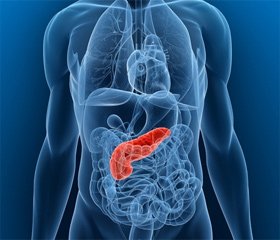Международный эндокринологический журнал 3 (67) 2015
Вернуться к номеру
Diagnostic markers and the method of predicting of chronic pancreatitis in patients with type 2 diabetes mellitus
Авторы: Zhuravlyova L.V. , Shekhovtsova Y.O. - Kharkiv national medical university; Arsenyev A.V. - National Pharmaceutical University, Kharkiv, Ukraine
Рубрики: Эндокринология
Разделы: Клинические исследования
Версия для печати
Introduction
Diabetes mellitus is one of the most common diseases in the world, type 2 diabetes mellitus (T2DM) dominated in its structure. The number of the T2DM patients is more than 350 million now.
According to the epidemiological studies, 28-36% of T2DM patients have chronic pancreatitis (CP). The main pathogenesis links of T2DM have a close connection with the functional status of the pancreas.
For the diagnosis of CP, especially early, there is a need to study new markers of disease, such as adipose tissue hormones – namely, apelin, IL-1, TNF-α. Their diagnostic role requires careful study and research.
The purpose of the present study was to determine the diagnostic markers and the method of predicting of CP on T2DM patients.
Materials and methods.
A total of 94 patients with T2DM (33 men, mean age 58.94 ± 1.02 years) were examined. Examined patients were divided into 2 groups: 1st group – patients with T2DM (n=32), 2nd group – patients with combined course of T2DM and CP (n=62). The following parameters were determined in examined patients: body weight, height with subsequent calculation of body mass index (BMI) using the formula: BMI (kg/m2) = weight (kg) / height (m2).
For the purpose of our research all patients were tested for serum glucose by glucose-oxidase assay by standard method; the level of glycosylated hemoglobin (HbA1c) – kinetic method; the level of immunoreactive insulin (IRI) – ELISA method; indicators of lipid metabolism by standard method. Evaluation of IR was conducted using homeostasis model assesment (HOMA) using the formula: HOMA-IR = IRI, mcU/ml * serum glucose, mmol/L / 22.5. The content of apelin (C-Terminus peptide) and TNF-α were determined by immune-enzyme assay «Raybiotech» and «Vector-Best» set of reagents.
Correlation analysis was performed among all studies parameters according to their distribution law using Statistica 6.0 licensed program.
Results.
In the study of the functional state of the pancreas the levels of elastase-1 were significantly lower in the 2nd group patients compare with the 1st group (р<0.05). The level of CRP in the blood was significantly increased in 2nd group patients compared to the 1st group (р<0.05) and correlated with BMI (r=0.41; р<0.05), glucose (r=0.50; р<0.05), НОМА-IR (r=0.57; р<0.05), TG (r=0.58; р<0.05).
Decreased tissue sensitivity to insulin was determined by criteria НОМА-IR in 94% of all patients. It was revealed, that НОМА-IR was correlated with elastase-1 (r= -0.56; р<0.05), CRP (r=0.57; р<0.05), BMI (r=0.52; р<0.05), TG (r=0.34; р<0.05).
Disorders of the lipid metabolism were more often in the 2nd group patients compare with the 1st group (р<0,05). Hypercholesterolemia were found in 79% cases, increased level of LDL – in 93.5%, decreased level of HDL – in 87% of the 2nd group patients. The level of total cholesterol was significantly higher in the 2nd group patients compare with the 1st group (р<0.05). We found 1.2-fold increase in TG levels in the 2nd group patients which was significant higher than in the 1st group (p<0.05).
In the analysis of adipocytokines significantly higher levels of apelin and TNF-α in blood in the 2nd group patients compare with the 1st group (р<0.05) were found. In the 2nd group were revealed correlations between: TNF-α and elastase-1 (r= -0.66; р<0.05), TNF-α and CRP (r=0.48; р<0.05), apelin and BMI (r=0.50; р<0.05), apelin and total cholesterole (r=0.38; р<0.05), apelin and LDL (r=0.38; р<0.05), apelin and TG (r=0.56; р<0.05), apelin and glucose (r=0.59; р<0.05), apelin and HOMA-IR (r=0.70; р<0.05), apelin and HDL (r= -0.41; р<0.05).
The results of discriminant analysis allowed to rank the selected predictors on the importance of their contribution in classification in that order: elastase-1, CRP, apelin, α-amilase and HbA1c. According to this analysis prognosis of the presence of CP in patients with T2DM due to lower of elastase-1 and increased CRP, apelin, α-amilase and HbA1c. Prognostic value of this method was determined by such criteria: sensitivity – 93.55%, specificity – 83.37%.
Conclusions
1. Significantly increased levels of apelin and TNF-α, and worsening of indicators of carbohydrate, lipid metabolism and functional state of the pancreas were determined in combined course of CP and T2DM.
2. Correlations between levels of apelin, TNF-α, indicators of carbohydrate, lipid metabolism and functional state of the pancreas were found in patients with combined pathology.
3. At the result of the study basic diagnostic markers of CP in T2DM: CRP, α-amilase, apelin and elastase-1 were determined. The method of prognosis of CP in patients with T2DM was found.

